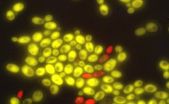(Press-News.org) Bisexual males and females report poorer health than gays, lesbians and heterosexuals, according to a new study from sociologists at Rice University.
"A New Piece of the Puzzle: Sexual Orientation, Gender and Physical Health Status" will appear in an upcoming edition of Demography. The study examined the self-rated health of 10,128 sexual minorities (gay, lesbian and bisexual adults) and 405,145 heterosexual adults to see how it differed across sexual orientation.
"According to the Institute of Medicine, existing health research on the sexual minority population is sparse and typically does not make distinctions between the different types of sexual minorities," said Bridget Gorman, a professor of sociology at Rice and the study's lead author. "We developed this study both to examine the health of these different sexual minority groups and to assess how risk factors for poor health contribute to their overall health."
In addition to recording self-rated health information, the researchers analyzed the participants' lifestyle according to a number of factors that traditionally impact health, including socio-economic status (including education level, employment status, household income and access to health insurance), health behaviors (smoker or nonsmoker, drinking habits, body mass index and access to health care) and social support and well-being.
The study found that 19.5 percent of bisexual men and 18.5 percent of bisexual women rated their health as "poor or fair," the highest proportion among the groups surveyed. In contrast, only 11.9 percent of men identifying as gay and 10.6 percent of women identifying as lesbian rated their health as "poor or fair," the lowest proportion of those surveyed. Health was also rated poor by 14.5 percent of heterosexual men and 15.6 percent of heterosexual women.
Across the groups surveyed, the researchers also found that bisexual men and women are disproportionately disadvantaged on important social, economic and behavioral factors strongly associated with health and well-being. For example, bisexual men and women were the least likely of the three groups to be college-educated. (Only 26.5 percent of bisexual men and 32.1 percent of bisexual women were college graduates, compared with 55.7 percent of gay men and 57 percent of lesbian women and 37.9 percent of heterosexual men and 37.5 percent of heterosexual women).
Bisexual men and women were more likely to smoke (23.8 percent and 21.9 percent, respectively), compared with 14.9 percent of gay men, 16.6 percent of lesbian women, 11.1 percent of heterosexual men and 8.3 percent of heterosexual women.
Bisexual men and women were the most likely of the three groups to have an annual household income of less than $25,000; 39.5 percent of bisexual men and 42.1 percent of bisexual women fell into this category, compared with 22.9 percent of gay men, 25.4 percent of lesbian women, 24.8 percent of heterosexual men and 29.5 percent of heterosexual women.
"If bisexuals are minorities within the minority and experience unique and more extreme forms of discrimination, this might contribute to disparities in things like earnings, educational attainment, the propensity to smoke cigarettes and other factors that affect well-being," said Justin Denney, director of the Kinder Institute for Urban Research's Urban Health Program and an assistant professor of sociology at Rice.
Both Gorman and Denney said that the study has important implications for the study of the health of sexual minorities.
"Our study illustrates the importance of examining health status among specific sexual minority groups, and not among 'sexual minorities' in the aggregate, since the health profile of bisexual adults differs substantially from that of gay and lesbian adults," Gorman said.
INFORMATION:
Hilary Dowdy, a graduate of Rice, and Rose Medeiros, a senior statistician at StataCorp, co-authored the study.
For centuries, humans have been playing with yeast. But these simple fungal cells usually do their jobs -- making bread rise or converting sugar into alcohol -- without having to communicate or work together.
Now, a team of University of Washington researchers has engineered yeast cells (Saccharomyces cerevisiae) that can "talk" to one another, using a versatile plant hormone called auxin.
In a paper published June 23 in the American Chemical Society's journal ACS Synthetic Biology, the researchers describe a novel cell-to-cell communication system that enables one ...
People on a vegetarian diet, and especially those following a vegan one that includes no animal products, see better results than dieters on other weight-reducing plans. In fact, they can lose around two kilograms more on the short term, says Ru-Yi Huang of E-Da Hospital in Taiwan after reviewing the results of twelve diet trials. The findings¹ appear in the Journal of General Internal Medicine², published by Springer.
Huang's review includes twelve randomized controlled trials, involving 1,151 dieters who followed a specific eating regime for between nine ...
German researchers found osteopathic manipulative therapy (OMTh) decreased postpartum low back pain by over 70 percent in women who had given birth at least three months before beginning treatment, according to a new study published in July issue of the Journal of the American Osteopathic Association.
The eight week study, devised as a pragmatic randomized controlled trial, surveyed 80 women experiencing low back pain three to 15 months postpartum. Women in the study group received four OMTh treatments at two week intervals. Participants in the control group did not ...
LA JOLLA-- Mice that have a genetic version of mitochondrial disease can easily be mistaken for much older animals by the time they are nine months old: they have thinning grey hair, osteoporosis, poor hearing, infertility, heart problems and have lost weight. Despite having this disease at birth, these mice have a "secret weapon" in their youth that staves off signs of aging for a time.
New research from the Salk Institute reveals how a longevity hormone helps these mice--born with thousands of mutations in their energy-generating mitochondria--maintain metabolic homeostasis ...
Forest composition, ground cover and topography are the best predictors of forest fire severity in the Western U.S., according to Penn State physical geographers who also see that the long history of fire exclusion on federal lands leads to uncharacteristically severe burns and potentially changes the dynamics of forests and their recovery.
A hunter's illegal campfire in Stanislaus National Forest adjacent to Yosemite National Park started what would become the Rim fire, the third largest fire in California history, that burned from August through October 2013. The fire ...
WEST LAFAYETTE, Ind. - Researchers who developed a high-speed form of atomic force microscopy have shown how to image the physical properties of live breast cancer cells, for the first time revealing details about how deactivation of a key protein may lead to metastasis.
The new findings also are providing evidence for the mechanisms involved in a cell's response to anti-cancer drugs, said Arvind Raman, Purdue University's Robert V. Adams Professor of Mechanical Engineering.
In atomic force microscopy (AFM), a tiny vibrating probe called a cantilever passes over a material, ...
This news release is available in French. Montreal, June 30, 2015 -- Unsafe drinking water is a topic usually connected to the developing world. But the regular recurrence of boil-water advisories, and widely publicised outbreaks in towns like Walkerton and Kashechewan have shown that, even in Canada, clean water cannot be taken for granted.
The increased scrutiny that arose from such issues has resulted in widespread criticism of the uneven drinking water regulation among Canada's provinces and territories.. However, centralizing water regulation is not necessarily ...
The Southern Pacific Ocean Tropical Cyclone Season just got an extension with the birth of a new tropical depression near the Solomon Islands. NASA's Aqua satellite passed over the new depression and saw that it was already affecting some of the islands.
The Solomon Islands make up a nation that consists of hundreds of islands in the South Pacific.
The MODIS or Moderate Resolution Imaging Spectroradiometer instrument aboard NASA's Aqua satellite captured a visible image of Tropical Depression 25P as it was forming in the Southern Pacific, just north of the Solomon ...
NASA-NOAA's Suomi NPP Satellite passed over the newborn ninth tropical depression of the Northwestern Pacific Ocean typhoon season on June 30.
At 02:55 UTC (10:55 p.m. EDT, June 29), the VIIRS or Visible Infrared Imaging Radiometer Suite (VIIRS) instrument aboard NASA-NOAA's Suomi satellite captured a visible image of the newly developed depression. The VIIRS image revealed bands of thunderstorms wrapping into the low-level center from the north and western quadrants.
VIIRS collects visible and infrared imagery and global observations of land, atmosphere, cryosphere ...
CHICAGO -- While studying Yersinia pestis, the bacteria responsible for epidemics of plague such as the Black Death, Wyndham Lathem, Ph.D., assistant professor in microbiology-immunology at Northwestern University Feinberg School of Medicine, found a single small genetic change that fundamentally influenced the evolution of the deadly pathogen, and thus the course of human history.
In a paper published in Nature Communications, Lathem and first author Daniel Zimbler, Ph.D., a Feinberg post-doctoral fellow, demonstrated how the acquisition of a single gene caused the ...




